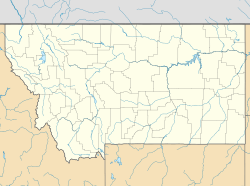St. Mary's Mission (Montana) facts for kids
Quick facts for kids |
|
|
St. Mary's Church and Pharmacy
|
|

Side and rear of the church
|
|
| Location | North Avenue, Stevensville, Montana |
|---|---|
| Area | 2 acres (0.81 ha) |
| Built | 1866 |
| NRHP reference No. | 70000364 |
| Added to NRHP | October 6, 1970 |
The Historic St. Mary's Mission is a special place in Stevensville, Montana. It was started by a group of Catholic priests called the Jesuits. This mission was built in 1841 to be a village for the Catholic Salish Indians.
St. Mary's was the very first lasting settlement made by non-Native American people in what is now the state of Montana. The main church building was rebuilt in 1866. This important site was added to the National Register of Historic Places in 1970.
Contents
The Salish People Seek Priests
The Salish people learned about the Jesuits from Catholic Iroquois fur trappers. These trappers settled among them around 1811 or after 1816. One Iroquois man named Ignace, also known as Big Ignace, told exciting stories about the "Black Robes." This was a nickname for the Jesuit priests because of their black clothes.
The Salish sent groups to St. Louis in 1831 and 1835. They wanted a priest to come back with them to their land. But both trips were not successful.
In 1837, another group, including Ignace, was attacked by Lakotas near Ash Hollow, Nebraska. They were killed while trying to reach St. Louis. Then, in 1839, two Iroquois Indians met Father De Smet by chance. They were at Council Bluff and told him about the Salish people's request.
In July 1840, Father De Smet met more than 1,000 Salish and Pend d'Oreille Indians. This meeting happened in Pierre's Hole. He promised them that he would return with priests within a year.
On September 24, 1841, Father De Smet kept his promise. He came back to the Salish in the Bitterroot Valley. With him were Fathers Gregory Mengarini and Nicholas Point. Also, Brothers Joseph Specht, William Claessens, and Charles Huett joined them.
Building the First Mission
Brother Claessens was a skilled carpenter. He was in charge of building the first church at St. Mary's. Pierre-Jean De Smet oversaw the construction. He described how the Salish people helped build the church: The women and their husbands worked very hard. They cut down trees quickly and eagerly. In just a few weeks, they built a log church. It was big enough for 900 people. To make the inside beautiful, the women used mats made from long grass. These mats were hung on the roof and sides. They also covered the floor. The church was decorated with branches of cedar and pine.
Nicolas Point had a plan for the village. He wanted houses with lawns. These houses were built according to his plan. However, this design made the village open to attacks. A strong fence, called a palisade, was built to protect the church. The first Holy Communion was held at Easter in 1842. At this time, Chief Victor was the main leader for the Bitterroot Salish.
Father Anthony Ravalli joined the mission in 1845. He helped the Native Americans by giving them shots to protect them from smallpox. He also managed the mission's health clinic.
By 1846, the mission's fields grew a lot of food. They produced 7,000 bushels of wheat. They also grew many garden crops. But by this time, many Salish Indians had left the mission. They slowly went back to their old way of life. They felt upset because a mission was built for the Blackfeet at Colville. The Blackfeet were their enemies.
Mission Closes and Reopens
In 1850, the mission had to close. This was because of attacks by the Blackfeet Indians. The church was left empty and then burned down. This was a common practice during such raids. The Jesuits then sold the village to a trader named John Owen for $250. This happened even though the village was built on Salish land.
After sixteen years, St. Mary's Mission started again in 1866. It was built about a mile south of the first village. The Catholic Salish people came to sermons in the new church. Later, settlers in the area also began to attend. The church was made larger in 1879.
In October 1891, Chief Charlo and the Bitterroot Salish were forced to move. They had to go to the Jocko Reservation. This marked the end of St. Mary's as a mission for Native Americans. In 1921, the church became St. Mary's Parish.
In 1953, work began on a new chapel. When it was finished in 1954, the historic St. Mary's chapel was no longer used for regular services. It was repaired and restored in the 1970s and 1980s. The Jesuits' kitchen was also rebuilt. In 1996, a visitor center and museum were added. The St. Mary's Mission Historic District was added to the National Register of Historic Places in 2010.
Visiting St. Mary's Mission Today
Today, you can visit the mission complex from April through October. The buildings you can see include the chapel with a house attached to it. There is also an infirmary, which was like a small hospital. You can also see a dovecote, which is a home for doves. There is a cabin with Salish artifacts, which are old items made by the Salish people. The visitor's center has a museum, a research library, an art gallery, and a gift shop.



